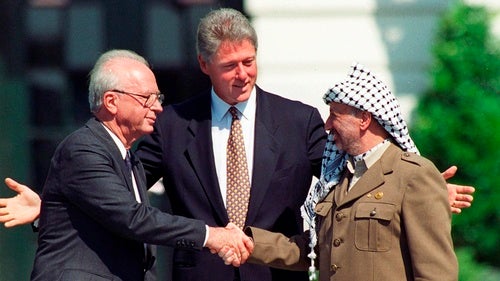How much Financial Assistance has the US Given the Palestinian Territories?

The U.S. is among the top donors to a United Nations agency that runs Palestinian refugee camps.
In short: After the latest Israel-Hamas war broke out on Oct. 7 and Israel began a siege on the Gaza Strip, President Joe Biden announced $100 million in “humanitarian assistance for the Palestinian people in Gaza and the West Bank.” Biden also sent Congress a request on Oct. 20 for $14.3 billion in aid for Israel. While the U.S. and Israel have what has historically been called a “special relationship,” the U.S. has given funds directly to the Palestinian territories as well and is often among the top donors to a United Nations agency that runs Palestinian refugee camps.
When did U.S. aid to the Palestinian territories start?
The U.S. gives aid to the Palestinian territories in two ways:
- Direct funds to the Palestinian territories (also called bilateral aid). This can come directly from Congress or through government agencies like the United States Agency for International Development (USAID) or the Economic Support Fund (ESF), which provides economic development funding abroad.
- Contributions to the U.N. Relief and Works Agency for Palestine Refugees (UNRWA), which operates 58 refugee camps, including in Gaza and the West Bank.
During the war, Israel took over 77% of the region, and more than “half of the Palestinian Arab population fled or were expelled.” In 1967, an estimated 500,000 Palestinians fled the West Bank and Gaza. Those who fled due to the 1948 war, as well as the descendants of male refugees, are officially defined as “Palestine refugees” by the U.N.
Since 1950, the U.S. has contributed over $6 billion to the UNRWA. The U.S. is one of the UNRWA’s largest contributors, along with Germany, the EU, and Sweden, which together make up 61.4% of the total funding. (Here’s a full UNRWA donor list going back to 2006.)
Direct aid from the U.S. to the Palestinian territories began in 1994, when an initial agreement was reached for “Palestinian self-rule” in Gaza and the West Bank; that aid totals over $5 billion.
In total, the U.S. has given the Palestinian territories over $11 billion since 1950, including the $6 billion given to the UNRWA. It’s given Israel “$318 billion since the end of World War II,” according to PolitiFact.
How has U.S. aid changed?
Bilateral U.S. aid to the Palestinian territories increased in 2007, after Hamas and Fatah were unable to maintain a coalition government in the Palestinian Legislative Council. Fighting broke out, and Hamas eventually took control of Gaza.
But according to a 2018 Congressional Research Service report, since 2010, “the executive branch and Congress have taken various measures to reduce or delay U.S. aid to the Palestinians.”
These reductions included former presidents Barack Obama and Donald Trump lowering the baseline funding for the ESF and for the International Narcotics Control and Law Enforcement, which gave assistance to the Palestinian Authority to “train, reform, advise, house, and provide nonlethal equipment for PA civil security forces in the West Bank loyal to President [Mahmoud] Abbas.”
One of Obama’s last actions in office was to send $221 million to the Palestinian Authority, which governs part of the West Bank; Trump later blocked the aid.
In 2018, the Trump administration cut over $200 million in bilateral Palestinian aid and reduced UNRWA funding by $300 million.
Then in 2019, the U.S. froze all aid to the West Bank and Gaza over an anti-terrorism law. The law allows “Americans to sue those receiving foreign aid from their country in US courts over alleged complicity in 'acts of war.'" The Palestinian Authority asked the U.S. State Department to stop all aid, according to a BBC report, for fear of lawsuits.
In 2020, the law was amended to be more specific, subjecting “to U.S. jurisdiction anyone making a payment to a convicted terrorist or their family member, anyone who maintains an office or headquarters in the U.S. (with certain exceptions, including offices maintained for the purposes of conducting business with the United Nations), or anyone who conducts activity in the U.S. on behalf of the Palestinian Liberation Organization or the Palestinian Authority,” but opening up the door to otherwise send aid.
What is aid like now?
In April 2021, Biden resumed sending U.S. aid to the Palestinian territories, and in March 2022 Congress approved $219 million in aid for Palestinians. In July 2022, the Biden administration announced an additional $200 million to UNRWA.
USAID announced it had spent $150 million in the Palestinian territories in 2022 and will spend $500 million between 2021 and 2024.
On Oct. 18, Biden announced $100 million in humanitarian aid due to the Israel-Hamas war and Israel’s ongoing siege, which has cut off access to food, water, and electricity in Gaza.
“This funding will help support over a million displaced and conflict-affected people with clean water, food, hygiene support, medical care, and other essential needs,” according to a White House statement.

